The Official F-15 Strike Eagle Handbook
by Richard Sheffield
Air Combat Basics
The aerial chess game of move and countermove, one plane against another, has been a difficult thing for experts to pin down over the years. The rules are constantlychanging; what worked yesterday may not work tomorrow, or the latest technology may be defeated by an obsolete system in actual combat conditions.
Regardless of the level of sophistication of the equipment, however, the most important measure of a country's air power is how well the pilots can tactically maneuver to utilize and deliver the weapons available. It has been shown over and over that flying skills and aggressiveness can overcome more recently developed weapons and superior numbers.
Despite all these changes, certain basic principles have remained constant over the years. The effectiveness of an attack is basically determined by four criteria, which are listed here in order of priority.
Surprise
Although surprise isn't often possible with the F-15 Strike Eagle simulation, it can be accomplished by firing medium-range missiles early, as soon as an enemy aircraft is detected coming toward you.
Surprise can also occasionally be gained by detecting an enemy with long-range radar and making a wide, slow turn to position yourself behind the opponent. Once in the favorable position, accelerate and close fast.
CAUTION |
In actual air combat, surprise has always been the dominant factor in victory. Four out of five defeated pilots didn't know they were under attack until it was too late to maneuver to safety. Stay alert. |
Teamwork
Teamwork is the second most important factor. Unfortunately, you're all by yourself when flying your F-15 Strike Eagle simulator. You'll be responsible for carrying out your assigned mission totally by yourself, no wingman to watch your six. (However, two-person play with one flying the plane and the other operating the keyboard can greatly improve your chances for survival.)
Maneuverability
Historically, only one out of five kills has been made by outmaneuvering an opponent, but when you're involved in a low-speed turning dogfight, outmaneuvering suddenly becomes very important. Develop and practice your skills.
Weapons
As the lethality of weapons used in air-to-air combat has increased, the targets have become harder to hit due to their increased speed and maneuverability. All things considered, the current close-range missiles aren't much deadlier than the machine guns used during World Wars I and II.
Aerial Combat
Aerial combat can be broken down into five stages:
• Detection
• Closing
• Attack
• Maneuvering
• Disengagement
Although in actual practice some of these phases may be skipped, each needs to be examined and understood.
Detection
The earlier you detect the position and course of an enemy aircraft, the more time you'll have to form a battle plan and maneuver to a favorable position to attack or avoid.
NOTE |
When you're not actively engaged in combat, dodging SAMs, or on a bombing run, always keep your radar in the long-range mode. |
Closing
Once an enemy has been detected, you must make a decision whether or not to close. You must evaluate the damage condition of your airplane, the amount of fuel you have remaining, your current mission, and your weapons remaining in order to make this decision. In some cases, it's best to continue a bombing run or head for home.
If you do choose to attack, you should close as quickly as possible. Your direction of approach will primarily depend on the enemy's path in relation to yours. If the enemy aircraft is flying across your path or away from you, try to get close behind it as quickly as possible, before it has a chance to turn toward you.
If the enemy plane is coming directly at you, you can try for lateral separation for a turn back. If he won't let you, you must close head-on.
Attack
Getting off the first shot is important. With an F-15, this usually means a medium-range missile shot followed by an attempt to get behind the enemy plane to follow up with a Sidewinder missile or guns. Your best move is to attack from behind. If that isn't possible, the head-on approach is your next choice.
You must also decide which weapon to use. Medium-range missiles may be out of the question at this point due to the minimum-range requirements. If Sidewinders are chosen, care should be taken not to get too close during the attack. If the first-shot attack isn't successful, you'll move on to the next phase of air combat.
Maneuvering
If your long-range or rear surprise attack isn't successful, you must then try to outmaneuver your opponent. Decide beforehand what type of weapons you want to attack with and what type of flight plan you'll follow.
If you're at low altitude (below 2000 feet), a close-range turning fight is going to be tough. The energy you lose during this kind of flight can put your aircraft in a stall. You can quickly find yourself out of altitude, out of energy, and out of ideas. At low altitudes, it's best to keep your speed up.
At higher altitudes, a close-range, turning, gun attack is possible. Your first move for this type of fight is to cut your power to 75 or 80 percent, which gives you the best turning performance. You may need to increase power during a sustained turn to avoid stalling. Keeping your speed low also keeps the enemy in front of you—you're less likely to overshoot.
Turning Options
Once you decide to engage a bogey from head-on, you have a number of options when it comes to your opening move.
Lead turn. To perform this maneuver, put some lateral separation between yourself and your opponent; then turn early (before your opponent) toward the target. This will place you in an advantageous position behind the enemy.
CAUTION |
This is a timing maneuver, don't turn too early or the enemy may have a chance to react and get right on your tail. |
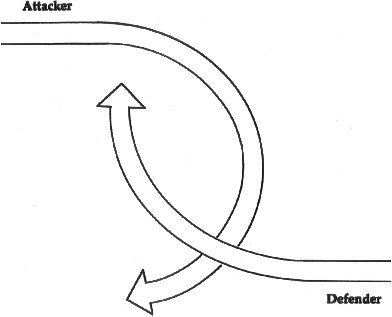
When an enemy aircraft Is approaching, turn before he does—chances are, you'll end up behind him.
Nose-to-nose turn. In a nose-to-nose turn, you turn away from your opponent at the time you pass. This may be a good idea if you want to bleed off some airspeed and climb a little during the turn.
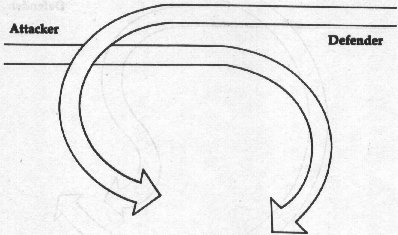
Turn away from your opponent to conduct a nose-to-nose turning maneuver.
If you've sufficiently reduced your speed, you may be able to reverse the turn once you spot the target, so you can fall in behind it.
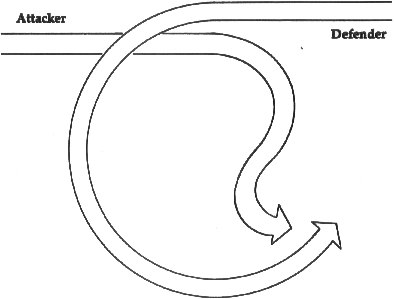
Reduce speed and reverse your turn, and you should be in a shooting position.
Nose-to-tail turn. In a nose-to-tail turn, you turn toward your opponent at the time you pass.
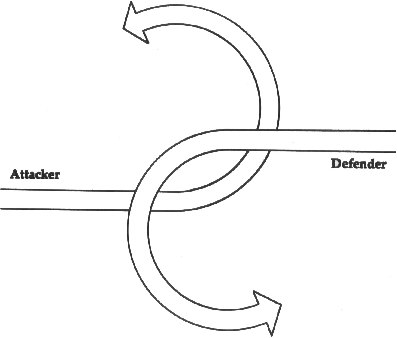
The aircraft with the best turning performance will be in the shooting position.
This puts you in a turning contest. You're chasing the bogey's tail and he's chasing yours. All things equal, the plane with the best turning performance will eventually catch up with the other and be in perfect position for a gun or short-range missile shot. However, pilots are rarely equal—just ask one. A clever pilot who knows how to manage his energy during the turning battle can frequently outmaneuver a lesser pilot in a more maneuverable aircraft. F-4 victories against the smaller and more maneuverable MiG-17s in Vietnam proved this.
Pursuit Options
The path you take when following a target is referred to as a pursuit curve. There are three kinds of pursuit curves: Lag, Pure, and Lead. Most rookies instinctively use Pure pursuit, in which they point the nose of their plane directly at the bad guy. This approach is okay, but seasoned pros know that Lead and Lag pursuit offer distinct advantages. Pursuit curves generally refer to one thing: where to point the nose of the aircraft. Following a Lead pursuit curve—keeping your nose ahead of the bad guy—assures that you can “pull lead” on the target for a good guns shot.
Here's why pulling lead is so important. If you're in a turning fight with another aircraft and you have your nose pointed directly at him, despite what you may think, he's perfectly safe. You see, it takes a certain amount of time for the shells you fire to travel the distance between you and the target. By the time the shells get there, the target will be gone. It's just like throwing a football to a running receiver: You don't throw it to where the receiver is, you throw it to where he will be by the time the ball gets there. The same thing applies to gunnery: You must shoot where the target will be, not where it is.
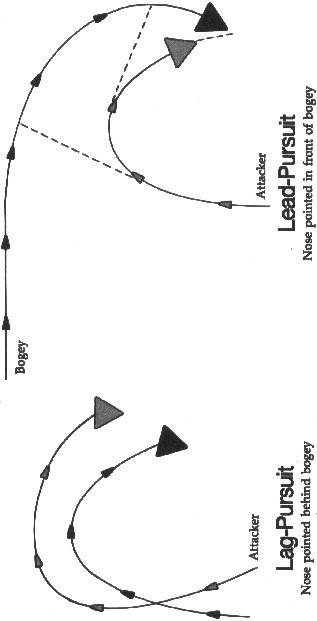
When you're following a target in a lead-pursuit curve, you have lead on that target. In other words, your nose is pointing in front of the target, not at it. This allows you to shoot where the target will be, not where it is. If you get into an engagement using lead pursuit from the beginning, you won't have to out-turn your opponent. Rather than flying straight at him, use the Tactical display or the TrackCam to see which way he's heading or turning; then approach him with your nose pointed in front of him, not at him.
CAUTION |
Be careful not to lead the target too much or he'll simply reverse his course and put you on the defensive. |
Lead pursuit will also allow you to close the range on a faster moving target by letting you “take a short-cut” and cut across the turning circle.
Lag-pursuit, or keeping your nose pointed behind the target, can be effectively used when you're trying to track a maneuvering target from the rear. In this case, trying to pull lead on the target may get you into trouble. What can happen is this: As you pull hard on the turn to get your nose ahead of the target, he reverses course and catches you going the wrong way. By keeping your nose pointed behind the target, he'll have to pass through your gunsights if he reverses course, giving you the chance for a quick guns shot. By maintaining a Lag-pursuit position, you'll also be able to maintain a speed advantage over the enemy. If he doesn't reverse, you may be able to force him into an ever-tightening turn. Sooner or later, he'll run out of airspeed or altitude and be forced to make a straight-line run for it. Then, you can use your speed advantage to close for a gun shot or to line him up for a missile.
Lateral Separation
Use lateral separation combined with lead pursuit to attack those unsuspecting targets. Putting a little space between your flight path and the bogey's will make your turn and attack much easier. That way, you won't have to turn and race after him, and you'll be able to keep your nose in front of the target the entire time. You can either maintain the lead pursuit until you close the range for a gun shot, or slide in behind him and put a Sidewinder up his tailpipe.
Maneuvering after the initial pass is discussed in detail later.
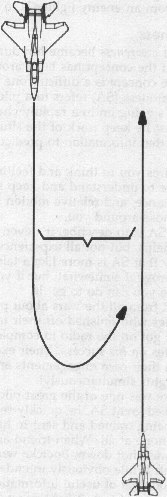
Disengagement
In the F-15 simulation, there's no real disengagement. The enemy fighters continue to follow you all the way back to the base, or until they're shot down. There are times, though, when it's necessary to put space between you and your opponent, to regroup or take a missile shot. These maneuvers are covered in detail in Chapter 9.
In F-15 Strike Eagle, as it has been historically, the best way to disengage from an enemy fighter is to shoot it down.
Situational Awareness
The term situational awareness became hot during and after the war in Vietnam, but the concept has been around since World War I. However, the concept is a difficult one to grasp. In general, situational awareness (SA) refers to a pilot's ability to keep up with what's going on in a rapidly changing environment. Not only must he keep track of the situation, he must also be able to use that information to predict what's about to happen.
Good SA requires you to think and feel in three dimensions and to be able to understand and keep track of various groups of time, distance, and relative motion as they apply to your aircraft and those around you.
As difficult as SA is to describe, it's even more difficult to teach. Experience helps, but not all experienced pilots have good SA. Some say that SA is more like a talent than a skill—hard work can improve it somewhat, but if you weren't born with it, there's little you can do to get it.
Stories abound from all the wars about pilots with great SA. They're the ones who finished off their targets in wild dogfights and then got on the radio to complement one of their squadron mates on his success. Their excellent SA allowed them to win their own engagements and keep up with several other dogfights simultaneously!
Oswald Boelcke was one of the great pilots of World War I. While he possessed great SA, he quickly realized that most of the new pilots being trained and sent to his squadron for combat possessed none at all. When friend and competitor Max Immelmann was shot down, Boelcke wrote a series of rules for air combat. While obviously intended for the novice, these contain a good deal of useful information applicable even in today's world of Mach-2 fighters and Mach-4 missiles.
Many of the rules deal with improving your own SA and reducing the enemy's.
Oswald Boelcke and the Eight Rules of Air Combat
Air combat has changed dramatically since World War I. Basic tactics and rules established by Oswald Boelcke in 1916, however, have stood the test of time well. These are eight rules of air combat designed to help new pilots survive and win.
1. Try to secure an advantage before you begin your attack. This advantage can be altitude, position, or surprise.
2. Always carry through with an attack once you've started.
3. Fire only at close range and when your opponent is properly in your sights. When applied to missile attacks, this means shoot when in good position with a good angle and within the minimum and maximum firing ranges. When applied to guns, it means fill the screen with the enemy plane.
4. Always keep your eye on your opponent. Don't be deceived by ruses. In F-15, this means be prepared for your opponent to cut his speed to force you to overshoot.
5. Always attack from behind your opponent. This isn't as important now as it was in 1916, although it still applies to a good gun attack.
6. When attacked, turn into the attack; don't try to evade. This still holds true. Always be on the offensive.
7. When over enemy lines, never forget your own line of retreat. When your fuel and/or weapons are low, start thinking about how you're going to get back to base.
8. Attack in groups of four or six. Unfortunately, you're by yourself in F-15.
This is the end of the ground training and familiarization section. Study this section and be prepared for anything the enemy can throw at you.
NOTE |
Remember that air battles are lost, not won. The pilot who makes the fewest mistakes wins. |
Table of Contents
Previous Section: The Fighter Pilot's Mission
Next Section: Part II: ACM (Air Combar Maneuvering)
